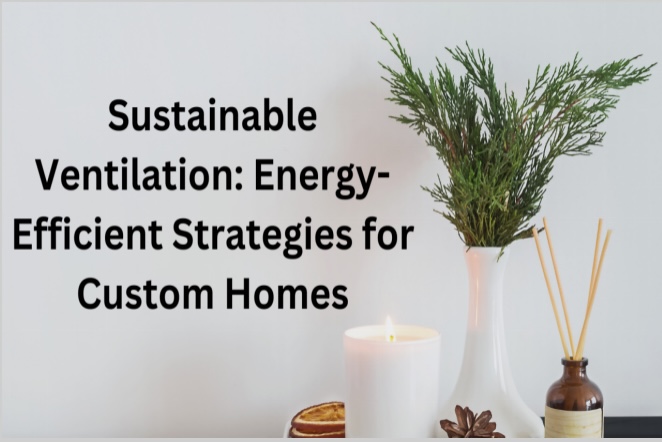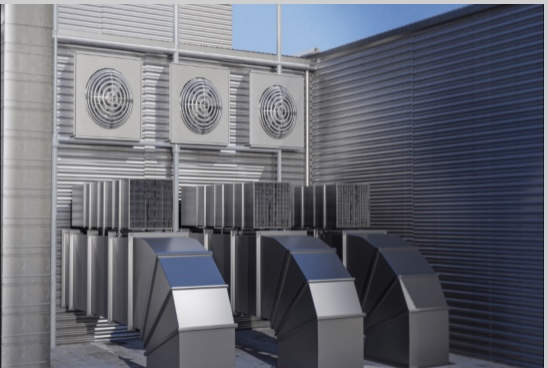Sustainable Ventilation: Energy-Efficient Strategies for Custom Homes

Finding solutions to reduce human interference with natural systems is more important than ever. We can get there by building sustainable custom homes and using less energy overall.
Energy efficiency is crucial, as costs are projected to rise by more than 3% this year. After the recent global weather disasters, this is more important than ever.
Designing for ventilation is crucial to your home’s inhabitants’ health and comfort. While generally effective, traditional ventilation systems might waste energy in certain circumstances. In such a scenario, eco-friendly ventilation systems are essential. Eco-friendly custom homes improve air quality, energy efficiency, and the environment.
Importance of Energy-Efficient Strategies for Custom Homes
Energy-efficient measures from the start can lower the cost of building a custom home. Energy-efficient homes with sustainable ventilation systems save money on utilities. Upgraded insulation, energy-efficient HVAC systems, and renewable energy save custom homeowners money.
Additionally, energy-efficient features make custom residences sustainable. They conserve natural resources and reduce carbon emissions and fossil fuel consumption. By building energy-efficient luxury custom homes, we demonstrate our commitment to sustainability. The value of a property increases as energy efficiency and sustainability are prioritized.
Invest in a home that saves on energy costs and helps the environment. Additionally, tax reimbursements and refunds could be advantageous for energy-efficient architecture. Given the cost to build custom home, energy-efficient solutions are economical and ecological.
Strategies for Energy-Efficient Ventilation in Custom Homes
Compared to traditional homes, most modern houses are constructed to conserve as much energy as possible. They can reduce your energy bill and save you more money in the long run if they’re well-made. A skilled custom home builder will meet family demands and design a durable, energy-efficient home.
If you want to build an eco-friendly home, here are some tips:

Photo by Canva
1. Natural Ventilation
Natural ventilation in custom homes is energy-efficient and environmentally friendly. Open floor plans, high ceilings, and well-placed windows, doors, and vents increase ventilation. Open windows on opposite sides of the residence to promote cross-ventilation.
By facing the building toward prevailing breezes, passive cooling, and air circulation can be optimized. Natural airflow lowers mechanical ventilation and enhances interior air quality.
2. Passive Cooling Techniques
In custom residences, passive cooling reduces reliance on mechanical cooling. Awnings, overhangs, and shading devices can block the summer sun and heat. Passive cooling elements reduce air conditioning use by blocking solar radiation. Eliminating artificial ventilation improves comfort, energy efficiency, and sustainability.
3. Energy Recovery Ventilation (ERV)
Energy recovery ventilation (ERV) systems in custom homes provide sustainable ventilation. Heat exchangers recover and exchange heat between air streams indoors and outdoors. Heat is transferred from stagnant indoor air to fresh outdoor air by the heat exchanger.
The preconditioning process warms or cools the incoming air. ERVs recover and reuse energy to minimize heating and ventilation demand. It also purifies the air for a healthier, more comfortable household.
4. Demand-Controlled Ventilation (DCV)
Custom house demand-controlled ventilation (DCV) saves energy based on occupancy and air quality. Sensors detect occupants and air pollutants to adjust ventilation accurately. DCV systems adapt ventilation rates to occupant needs and save energy.
To save energy, the technology lowers ventilation rates when occupancy or air quality is low. Under excessive occupancy or pollution, the device boosts ventilation. DCV systems enhance air quality and conserve energy.
5. Smart Ventilation Controls
Intelligent ventilation controls for luxury custom homes are compatible with home automation systems. These systems enable homes to adjust ventilation based on air quality, humidity, and temperature. Smart ventilation controls maintain comfort and health while saving energy.
These controls can function off-peak to save electricity. Custom-built homes have energy-efficient, personalized ventilation controls for the best indoor air quality.
6. High-Efficiency Ventilation Fans
In the bathrooms and kitchens of custom homes, high-efficiency ventilation fans are advantageous. Make sure to choose and install an energy-efficient ventilation fan. Fans with high ventilation remove moisture, odors, and contaminants from these areas.
Fans with high efficacy optimize airflow while conserving energy. For those looking to enhance their custom homes’ ventilation systems, Industrial Fans Direct offers a wide range of high-efficiency ventilation solutions, comparable to the best in the world, helping homeowners across the US and other countries achieve optimal indoor air quality. High-efficiency ventilation fans keep your home healthy and comfortable while reducing energy consumption.
7. Insulation and Air Sealing
By effectively insulating your home, you can save a lot of energy. Insulation decreases heat transfer through walls, ceilings, and floors. Air sealing prevents drafts and inefficient airflow from air leakage through fissures, gaps, and holes.
Sealing air leaks keeps conditioned air inside and reduces ventilation. A custom residence that is well-insulated and airtight promotes comfort and sustainability.
8. Zoned Ventilation
Zoned ventilation efficiently controls airflow in specific rooms in the home. Zoned ventilation systems let homeowners customize ventilation to their needs and space.
Lavatories and kitchens with many people or excessive humidity can emphasize ventilation. In contrast, airflow can be reduced in unoccupied or infrequently used areas. This method maximizes energy efficiency by directing circulation to the necessary locations. Zoned ventilation enhances indoor air quality while decreasing energy consumption.
9. Natural Ventilation Strategies
Natural ventilation is an excellent energy-efficient option for custom-built residences. Stack ventilation can enhance airflow beyond what is possible with natural ventilation. Variations in temperature influence stack ventilation.
Warm air can escape through windows or ducts near the ceiling at a height that allows it to rise. Lower apertures admit cooler air, thereby diffusing fresh air. This stack effect utilizes buoyancy to provide ventilation without mechanical equipment. Stack and natural ventilation improve airflow, energy efficiency, and cooling in custom homes.
10. Monitoring and Maintenance
Luxury custom home ventilation systems require monitoring and maintenance. Homeowners can quickly identify ventilation issues through monitoring. Cleaning or replacing air filters periodically prevents clogs and preserves ventilation.
To avoid air loss and distribute conditioned air, check ductwork for leaks. Professional inspections may reveal issues like poor insulation or damaged parts. Homeowners can save money and promote health by maintaining ventilation systems.
Wrapping Up
The environment and quality of life can be enhanced by energy-efficient ventilation. Improves air quality, comfort, energy efficiency, and emissions of greenhouse gasses.
An energy-efficient custom home requires a reliable custom home builder. A professional, quality-focused builder can be relied upon to manage everything. An energy-efficient custom home requires a reliable custom home builder.
To ensure energy efficiency and sustainability, in-house designers and builders are best. The collaborative design maximizes energy efficiency and sustainability.
With these tips and the right builder, you can build a beautiful, energy-efficient custom home. It also reduces heating and ventilation costs, providing comfort throughout the year.




























